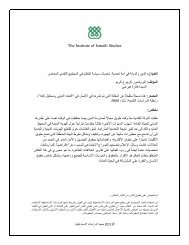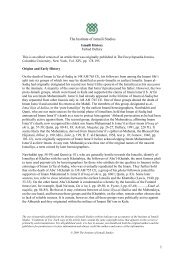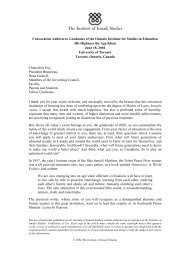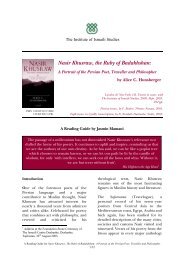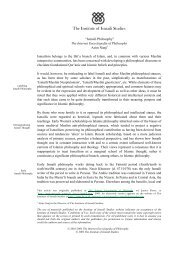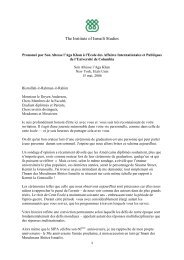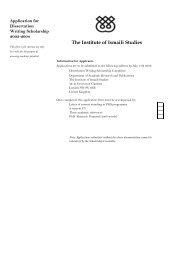BM-IIS Conference Pack.qxp - The Institute of Ismaili Studies
BM-IIS Conference Pack.qxp - The Institute of Ismaili Studies
BM-IIS Conference Pack.qxp - The Institute of Ismaili Studies
Create successful ePaper yourself
Turn your PDF publications into a flip-book with our unique Google optimized e-Paper software.
<strong>BM</strong>-<strong>IIS</strong> <strong>Conference</strong> <strong>Pack</strong>.<strong>qxp</strong> 20/03/2009 14:13 Page 16<br />
CHRISTIANE GRUBER<br />
“<strong>The</strong> ‘Restored’ Shi‘i Mushaf as Divine Guide?: <strong>The</strong> Practice <strong>of</strong> Fal-i Qur’an in the<br />
Safavid Period”<br />
This paper argues that the exponential growth <strong>of</strong> divinatory texts known as falnamas,<br />
attributed variously to the Imams ‘Ali, Husayn, and Ja‘far al-Sadiq, included at the end<br />
<strong>of</strong> Qur’ans produced during the Safavid period provide further evidence for the<br />
widespread interest in divination during the 16th and 17th centuries in Iran. Treatises<br />
on divination by the Qur’an (fal-i Qur’an) reveal that it was considered permissible to<br />
“seek guidance” (istikhara) by means <strong>of</strong> Holy Scripture at this time. On a more symbolic<br />
level, however, fal-i Qur’ans can be understood as a kind <strong>of</strong> restoration <strong>of</strong> the “defective”<br />
‘Uthmanic codex by re-Shi‘ifying it – if not by reinserting supposedly dropped verses on<br />
the Ahl al-Bayt, then at the very least by systematically adding terminal divinations<br />
attributed to the figureheads <strong>of</strong> Shi‘i Islam. This particular practice therefore follows the<br />
general “Shi‘ification” trends found in a number <strong>of</strong> cultural and artistic practices <strong>of</strong> the<br />
Safavid period, which also are discernible within the domain <strong>of</strong> Qur’anic production.<br />
Dr. Christiane Gruber (PhD (U Penn)) is Assistant Pr<strong>of</strong>essor <strong>of</strong> Islamic Art at Indiana<br />
University, Bloomington. She is the author <strong>of</strong> <strong>The</strong> Timurid Book <strong>of</strong> Ascension (Mi‘rajnama):<br />
A Study <strong>of</strong> Text and Image in a Pan-Asian Context (Valencia 2008), and Selections <strong>of</strong> Arabic,<br />
Persian, and Turkish Calligraphies (Washington 2006). She also wrote the entry on<br />
“Divination” in J. Meri (ed.), Medieval Islamic Civilization: An Encyclopedia, Vol.1 (New<br />
York and London 2006).<br />
VENETIA PORTER<br />
“Amulets, Heroes, and Shi‘ism”<br />
Paper Abstracts and Academic Biographies<br />
<strong>The</strong> use and meaning <strong>of</strong> amulets in Iran and the Shi‘a world belongs within the broader<br />
context <strong>of</strong> amulet use in different parts <strong>of</strong> the Muslim world. <strong>The</strong> objects that will be<br />
discussed in this paper, however, contain elements that associate them firmly with the<br />
Shi‘a world. Based largely on amulets in the collection <strong>of</strong> the British Museum, which<br />
range in date from the Safavid period or earlier, and up to amulets made in Iran today,<br />
this paper will examine what defines a Shi‘i amulet, the content and style <strong>of</strong> the<br />
inscriptions engraved upon such amulets, and the materials that are used to make<br />
them. Some <strong>of</strong> these amulets are engraved in reverse, whereas others are engraved in<br />
positive. <strong>The</strong>y take the form <strong>of</strong> objects that are worn or placed in the home. <strong>The</strong><br />
examples that are engraved in reverse belong in a category <strong>of</strong> amulet-seals that were<br />
made to be impressed, but these impressions do not survive, and how these amulets<br />
were used remains unclear. Also discussed will be the choice <strong>of</strong> particular Qur’anic texts<br />
on these amulets and how they combine with “Shi‘i phrases”. Other amulets that will<br />
be examined contain symbols and other esoteric elements which place them within the<br />
realm <strong>of</strong> magic. Finally, the context for the wearing <strong>of</strong> amulets in Iran will be touched<br />
upon using as an example the amulets worn by jahan pahlavan – world heroes – from<br />
the epic hero <strong>of</strong> the Shahnameh, Rustam, to the heroes <strong>of</strong> today.<br />
Venetia Porter is a curator in the department <strong>of</strong> the Middle East at the British Museum.<br />
She studied Arabic and Persian at the University <strong>of</strong> Oxford where she also did an M Phil<br />
in Islamic art. Her doctorate from the University <strong>of</strong> Durham is on the medieval history<br />
and architecture <strong>of</strong> the Yemen. At the British Museum where she has been since 1989,<br />
she is responsible principally for the collections <strong>of</strong> Islamic art from the Arab world and<br />
modern Middle Eastern art. Her research and publications have covered the areas <strong>of</strong><br />
ceramics and tiles, coins and inscriptions, aspects <strong>of</strong> medieval Yemen, and modern<br />
Middle Eastern art. She has also been working on seals and amulets and her catalogue<br />
<strong>of</strong> the British Museum’s collection <strong>of</strong> this material will appear in 2009. Articles on<br />
amulets include: “Amulets With the Names <strong>of</strong> the Seven Sleepers <strong>of</strong> Ephesus in the<br />
British Museum” in F. Suleman (ed.), Word <strong>of</strong> God, Art <strong>of</strong> Man: <strong>The</strong> Qur’an and its Creative<br />
Expressions (Oxford 2007); “Water and Magic and Magical Inscriptions on ‘Frozen<br />
Water’” in S. Blair and J. Bloom (eds.), Rivers <strong>of</strong> Paradise: Water in Islamic Art and Culture<br />
(New Haven 2009). She is also the curator <strong>of</strong> “Takhti: a Modern Iranian Hero”, an<br />
Objects in Focus exhibition which coincides with the British Museum’s major exhibition<br />
“Shah ‘Abbas: the Remaking <strong>of</strong> Iran”.



